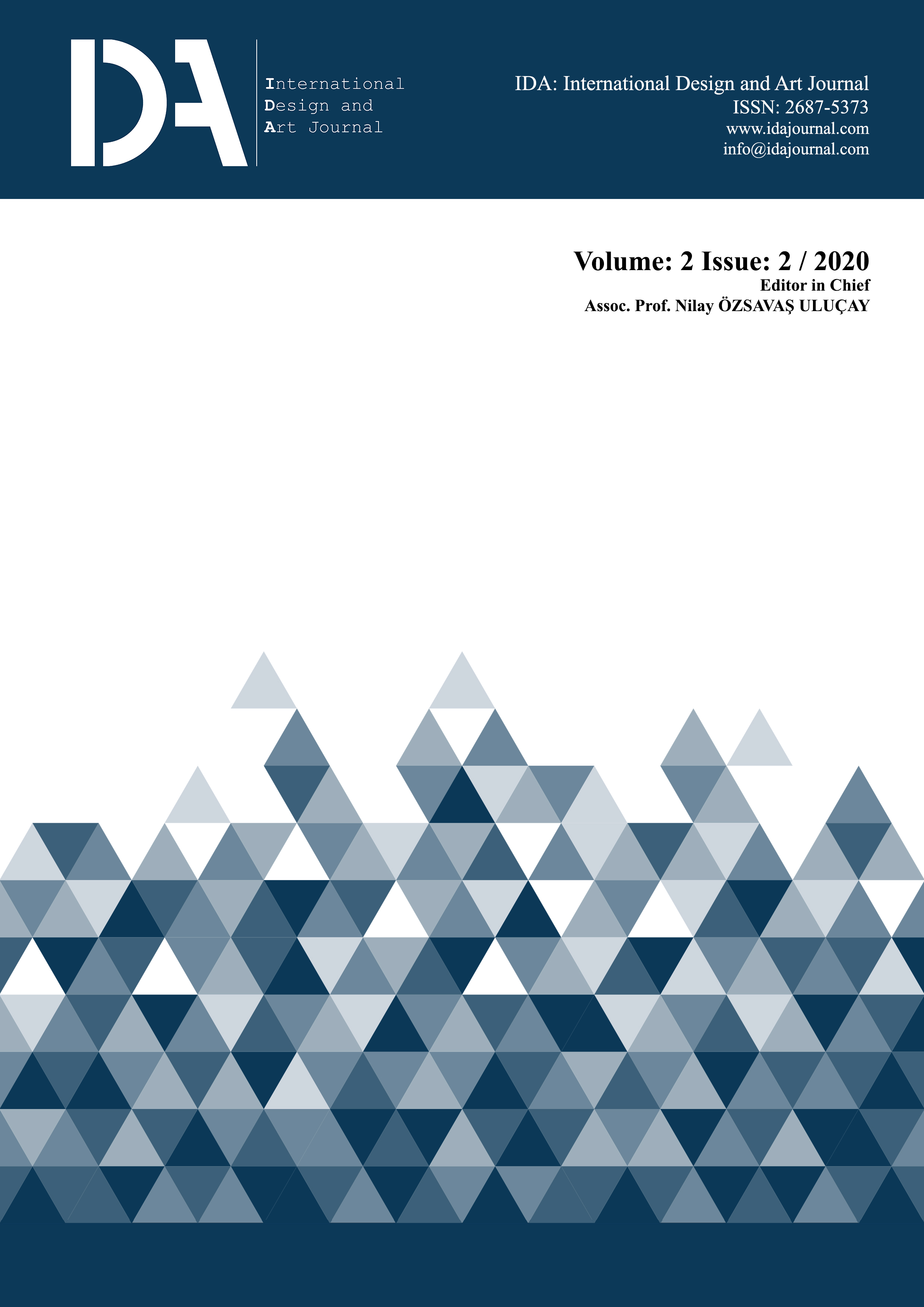The Use of Illustration Art in Children Oriented Indoor and Furniture Designs: Application Examples and Techniques
Keywords:
Illustration, Kid, Interior Design, FurnitureAbstract
Perception is the ability to organize and interpret the information around, since birth. For children between the ages of 0-6, the interior reinforcement elements in their own room and kindergarten, where they spend most of their time, are important in terms of perception and experiences with their functional and visual effects. The art of illustration is also very effective in the child’s perception of space. The aim of the research is to draw attention to the contribution of the illustration to the space in interior designs for children using illustration art. The formal features of the furniture used in children's rooms, which are places designed for children, constitute the subject of this research article. The abstract illustrative designs of living and inanimate beings, are seen in children products with different interpretations. Creative forms combine with functional furniture as the illustration affects stylistic features in product and furniture designs. This fact enhance the child's ability to interpret objects differently. In this study, the formal characteristics of illustrations used in children's spaces and on equipment elements are examined. In the design of children products, the criteria and factors affecting the children's furniture are investigated, and the furniture in illustrative forms are chosen, and its formal features and functions are examined.
The research is conducted by using qualitative methods like observation and analysis of documents. The designs which include illustrations were chosen from products, books and interior wall designs. In addition, the illustrations applied by different designers in furniture design have been stylistic and functionally tabulated. As a result, these designs, which affect the creativity of individuals from an early age, also play an important role in the development of the children’s imagination with their creative forms. The illustrations used in interiors and furniture designs for children, should be selected considering the age group and interests of the child. In terms of giving identity to the place, designs where illustration is used are preferred in places for children.
References
Andarood, H. G. (2014). İç Mimarlık Alanında Görsel İletişim Temelli Grafik Tasarım Çözümlemeleri. Yüksek Lisans Tezi, Hacettepe Üniversitesi Güzel Sanatlar Enstitüsü, Ankara.
Atan, U. (2013). Grafik İllüstrasyon Olarak Minyatür, Akdeniz Sanat Dergisi,11(6), 23-33.
Baksi, S. (2018). Çocukların Mekân Algısının Yaşam Çevresi Üzerinden İncelenmesi. Yüksek Lisans Tezi, Selçuk Üniversitesi - Hacettepe Üniversitesi Sosyal Bilimler Enstitüsü, Konya.
Bayazıt, N. (1994). Endüstri Ürünlerinde ve Mimarlıkta Tasarlama Metodlarına Giriş. İstanbul: Literatür Yayınevi.
Buldurlu, E., Kılıç, Y., İlçe, C., Elibol, C., Yener, G. (2004). Okul Öncesi Çocuk Mobilyaları ile İlgili Ebeveyn Görüşleri ve Öngörülen Mobilya Tasarım Ölçütleri. Teknoloji, 7(1), 139-149. http://jestech.karabuk.edu.tr/arsiv/1302-0056/2004/Cilt%287%29/Sayi%281%29/139-149.pdf
Chu, Y. (2018). Analysis of the Application of Illustration Art in Graphic Design Advances in Social Science. Education and Humanities Research, (246), s.539-541.
Atamaz Daut, E. (2017). Grafik Tasarımın Mekânsal İmaj Yaratımındaki Rolü, Doktora Tezi, Yakın Doğu Üniversitesi Sosyal Bilimler Enstitüsü Sanat ve Tasarım Ana sanat Dalı, Lefkoşa.
Demirarslan, D. (2019). 0-6 Yaş Grubu Çocuğun Dünyasında Mobilya Tasarımı. Researcher:Social Science Studies, 7 (2), s.64-76.
Demirarslan, D., Aytöre, O. S. S. (2004). Çocuğun Fiziksel Ve Ruhsal Gelişimi Açısından Çocuk Odaları Tasarımında Malzeme Kullanımı Ve Malzeme Seçiminin Önemi, 2. Ulusal Yapı Malzemesi Bildiri Kitabı, İstanbul.
Dilmaç, E. S. (2018). Anaokulları Sınıf Mekanlarında Rengin Çocuk Psikolojisine Etkileri, Yüksek Lisans Tezi, Maltepe Üniversitesi, İç mimarlık Programı, İstanbul.
Dinçel, K., Işık, Z. (1979). Mobilya Sanat Tarihi. İstanbul: Milli Eğitim Basımevi.
Ergün, E. (2012). Grafik Tasarımın İç Mekân Yüzeylerde Kullanımı, Doktora Tezi, Hacettepe Üniversitesi Sosyal Bilimler Enstitüsü, Ankara.
Fiell, C., Fiell, P. (2006). Design Handbook Concepts Materials Styles, Cologne: Taschen.
Gülpınar, F. (2010). Görsel Kavramlar, İllüstrasyon ve Çocuk Kitapları. Yüksek Lisans tezi, Haliç Üniversitesi Güzel Sanatlar Enstitüsü Grafik Tasarım Programı,İstanbul.
Nikolaeva, B. (2020). Types of Illustration Styles and Techniques. https://graphicmama.com/blog/types-of-illustration (05.05.2020).
Arıtan Ö., Taşçı B., Güller E., Özdemir N. (2018). Noktadan Mekana-2. İstanbul: Yalın Yayıncılık.
Tavakkoli, R. (2014). İç Mimaride Grafik Tasarım. Yüksek Lisans Tezi. Hacettepe Üniversitesi Güzel Sanatlar Enstitüsü İç Mimarlık ve Çevre Tasarımı Anasanat Dalı, Ankara.
Tavşan, F. (1995). Trabzon Konutları Üzerinde Çocuk Odaları Mekan ve Donatı Özellikleri Üzerine Bir Araştırma Yüksek Lisans Tezi. Karadeniz Teknik Üniversitesi, Mimarlık Anabilim Dalı, Trabzon.
Türk Dil Kurumu Sözlükleri, Erişim Adresi https://sozluk.gov.tr/ (20.04.2020).
Türkçe Bilgi (2020). İllüstrayon. https://www.turkcebilgi.com/ill%C3%BCstrasyon (10.06.2020).
Türk Edebiyatı (2020), Soyutlama. Erişim Adresi https://www.turkedebiyati.org/soyutlama-nedir-soyutlama-ornekleri-sorulari/ (10.05.2020).
United States Consumer Product Safety Commission. Childrens Products (2020), Children Products, Erişim Adresi https://www.cpsc.gov/Business--Manufacturing/Business-Education/childrens-products (15.05.2020).
Downloads
Published
Issue
Section
License
IDA: International Design and Art Journal is an open-access academic journal. All publishing rights of the accepted articles are deemed to assign to IDA: International Design and Art Journal. Articles can not be published and copied anywhere, and can not be used without reference.
IDA: International Design and Art Journal is licensed under a Creative Commons Attribution-NonCommercial-ShareAlike 4.0 International License.



